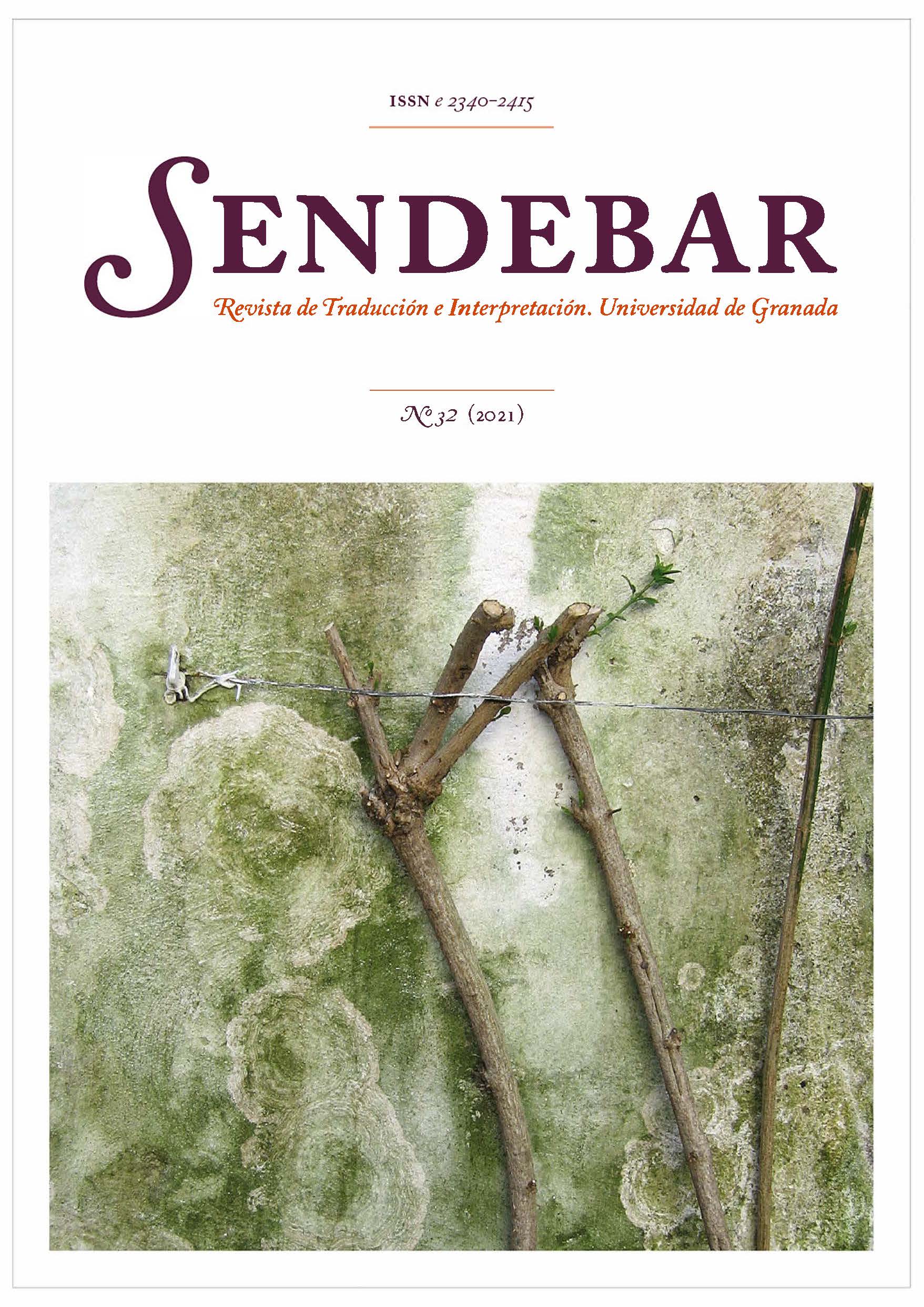The Chinese Literature Translator in Spain: An Interview-based Qualitative Study
DOI:
https://doi.org/10.30827/sendebar.v32.16493Keywords:
literary translation, Chinese-Spanish translation, profession, publishing houses, interview, professional profileAbstract
The profile and characteristics of Chinese-Spanish literary translators are still not well known. The objective of this study is to make them known through the analysis of 14 interviews. The results reveal that many do not have specific training; that the majority have stayed for some time in synophone-speaking countries; that the relationship with the publishers is smooth and some have even made proposals to them, despite not being able to make a living out of it; that the current training programs present some dysfunctions in relation to what the labor market demands from professionals and that the challenges they must face when translating are of various kinds, although the historical-cultural references stand out among the most recurrent. Finally, we point out some ideas that emerge from the results in order to improve translator training, as well as future lines of research related to the professional profile of translators.
Downloads
References
An, T. (2020). El papel de los paratextos en la traducción de la narrativa china al castellano y la creación de la imagen del «otro chino». [Tesis doctoral, Universitat Autònoma de Barcelona]. https://www.tesisenred.net/handle/10803/670327
An, T. (2021). La imagen del Otro chino a través de las portadas: un estudio empírico basado en un corpus de traducciones de narrativa china contemporánea al castellano y al catalán (1949-2019). Cultura, Lenguaje y Representación, 25, 11-31. http://dx.doi.org/10.6035/clr.2021.25.1
Balcom, J. (2005). An Interview with Burton Watson [Entrevista a Burton Watson]. Translation Review, 70, 7-12.
Casas-Tost, H. (2009). Análisis descriptivo de la traducción de las onomatopeyas del chino al español. Tesis doctoral, Universitat Autònoma de Barcelona]. http://grupsderecerca.uab.cat/txicc/sites/grupsderecerca.uab.cat.txicc/files/TESI%20HelenaCasas.pdf
Casas-Tost, H. (2014a). Translating onomatopoeia from Chinese into Spanish: a corpus-based analysis. Perspectives. Studies in Translatology, 22(1), 39-55. https://doi.org/10.1080/0907676X.2012.712144
Casas-Tost, H. (2014b). El estilo del traductor en el tratamiento de las onomatopeyas del chino al español: el caso de la novela ¡Vivir! Babel. Revue internationale de la traduction / International Journal of Translation, 60(4), 445-463. https://doi.org/10.1075/babel.60.4.03cas
Casas-Tost, H. y Rovira-Esteva, S. (2008). Chinese-Spanish translation studies in tertiary institutions in Spain: historical review and future perspectives [Los estudios de traducción chino-español en instituciones terciarias en España: repaso histórico y perspectivas futuras]. The Interpreter and Translator Trainer, 2(2), 185-202. https://doi.org/10.1080/1750399X.2008.10798773
Fernández Díaz, J. J. (2018). La traición fiel: conversación con Belén Cuadra Mora. Cartaphilus: revista de investigación y crítica estética, 16, 177-184.
Folch, D. (1985). Poesia xinesa i poesia xinesa en català [Poesía china y poesía china en catalán]. Reduccions: revista de poesia, 25, 57-86.
Folch, D. (1988). Traduïnt Wang Wei [Traduciendo a Wang Wei]. L’Avenç, 120, 38-40.
Franco Aixelá, J. (2001-2020). BITRA (Bibliografía de Interpretación y Traducción). Base de datos en abierto. https://doi.org/10.14198/bitra
Guber, R. (2001). Capítulo 4. La entrevista etnográfica o el arte de la «no directividad» en R. Guber, La Etnografía. En Método, Campo y Reflexividad (pp. 30-40). Grupo Editorial Norma.
Jankowska, A. (2019). Training future describers: A practice report from an audio description classroom [Formando a futuros audiodescriptores: un informe sobre las prácticas en una clase de audiodescripción]. Lingüística Antverpiensia, 18, 197-215.
Kuznik, A., Hurtado Albir, A. y Espinal Berenguer, A. (2010). El uso de la encuesta de tipo social en Traductología. Características metodológicas. MonTI. Monografias de Traducción e Interpretación, 2, 315-344.
Li, H. (2012). Translation of Contemporary Chinese Literature in the English-speaking World: An Interview with Nicky Harman [La traducción de la literatura china contemporánea en el mundo angloparlante: entrevista a Nicky Harman]. The AALITRA Review: A Journal of Literary Translation, 4, 18-25.
Marin-Lacarta, M. (2012). Mediación, recepción y marginalidad: Las traducciones de literatura china moderna y contemporánea en España. [Tesis doctoral, INALCO, Ecole Doctorale - Langues, littératures et sociétés du monde y Universitat Autònoma de Barcelona]. http://hdl.handle.net/10803/96261
Marin-Lacarta, M. (2014). Reclamos reiterativos en las traducciones de literatura china moderna y contemporánea en España. En G. García-Noblejas Sánchez-Cendal (Ed.), Estudios de traducción e interpretación chino-español (1.ª ed., pp. 57-101). Universidad de Granada.
Marin-Lacarta, M. (2019). Research methodologies, translation. En M. Baker y G. Saldanha (Eds.), Routledge Encyclopedia of Translation Studies (pp. 479-484). Routledge.
McDonough, J. (2015). A place for oral history within Translation Studies? Target. International Journal of Translation Studies, 27(2), 192-214. https://doi.org/10.1075/target.27.2.02mcd
Ministerio de Cultura y Deporte. (2018). Panorámica de la edición española de libros 2017. https://sede.educacion.gob.es/publiventa/d/21499C/19/0
Pallarés, C. (2001). Entrevista a Dolors Folch. Quaderns: revista de traducción, 6, 163-171.
Rovira-Esteva, S., Casas-Tost, H., Tor-Carroggio, I. y Vargas-Urpí, M. (2019-2021). La literatura china traducida en España. Base de datos en acceso abierto. https://dtieao.uab.cat/txicc/lite. https://doi.org/10.5565/ddd.uab.cat/214778
Stalling, J. (2014). The Voice of the Translator: An Interview with Howard Goldblatt [La voz del traductor: entrevista a Howard Goldblatt]. Translation Review, 88(1), 1-12. https://doi.org/10.1080/07374836.2014.887808
Taylor, S. J. y Bogdan R. (1987). Introducción a los métodos cualitativos de investigación: La búsqueda de significados. Paidós Básica.
Tor-Carroggio, I. y Rovira-Esteva, S. (2021). Chinese Literary Translation in Spain up until 2020: A Quantitative Approach of the Who, What, When and How. Skasse. Journal of Translation and Interpretation, 14(1): 67-95.
Wang, B. (2014). An Interview with Julia Lovell: Translating Lu Xun’s Complete Fiction [Entrevista con Julia Lovell: traduciendo Complete Fiction de Lu Xun]. Translation Review, 89(1), 1-14. https://doi.org/10.1080/07374836.2014.931268
Williams, J. y Chesterman, A. (2002). The Map: A Beginner’s Guide to Doing Research in Translation Studies. St. Jerome.
Zheng, J. (2020). A comparative philosopher’s study and translation of Sun Zi Bing Fa: An interview with professor Roger T. Ames [Un estudio filosófico comparativo y la traducción del Sunzi Bingfa: entrevista con el profesor Roger T. Ames]. Asia Pacific Translation and Intercultural Studies, 7(1): 104-115. https://doi.org/10.1080/23306343.2020.1737901
Downloads
Published
How to Cite
Issue
Section
License
Terminos de Licencia Sendebar.

















